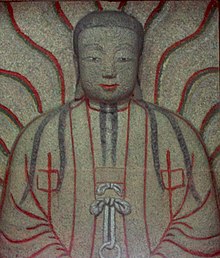พระมณี
มณี | |
|---|---|
مانی | |
 | |
| ส่วนบุคคล | |
| เกิด | ค.ศ. 216 |
| มรณภาพ | 2 มีนาคม ค.ศ. 274[2] (อายุราว 57–58) |
| สาเหตุการเสียชีวิต | ถูกประหารเพราะไม่ละทิ้งความเชื่อตามพระราชโองการของจักรพรรดิบาฮ์รามที่ 1 |
| ศาสนา | ศาสนามาณีกี |
| บุพการี | ปาติก (Pātik), มาเรียม (Mariam) |
| ก่อตั้ง | ศาสนามาณีกี |
พระมณี,[3] มานี (เปอร์เซีย: مانی), มานิส (กรีกโบราณ: Μάνης), มาเนส (ละติน: Manes) หรือ มานีหัยยา (ซีรีแอก: ܡܐܢܝ ܚܝܐ Mānī ḥayyā) เป็นศาสดาพยากรณ์และเป็นผู้ก่อตั้งศาสนามาณีกีชาวอิหร่าน[4][5][6][7] เป็นศาสนาแบบอไญยนิยมยุคปลายสมัยโบราณ เขาเกิดที่เมืองซีลิวเชีย-เทซิโฟนในบาบิโลเนีย[1] ซึ่งในเวลานั้นเป็นส่วนหนึ่งของจักรวรรดิพาร์เธีย งานเขียนของพระมณีจำนวนหกชิ้นเขียนด้วยภาษาซีรีแอก และงานเขียนชิ้นที่เจ็ดได้เขียนเป็นภาษาเปอร์เซียกลางถวายจักรพรรดิชาปูร์ที่ 1 แห่งจักรวรรดิซาเซเนียน[8]
พระมณีเห็นว่าตัวท่านเป็นศาสดาพยากรณ์คนสุดท้ายที่พระเป็นเจ้าส่งมาโปรดโลกมนุษย์ ต่อจากอาดัม โซโรอัสเตอร์ พระพุทธเจ้า และพระเยซู เขาได้ออกเผยแผ่ศาสนาจนแพร่หลายไปยังทวีปยุโรปและเอเชีย[3]
พระมณีถูกจองจำในคุกตามพระราชโองการของจักรพรรดิบาฮ์รามที่ 1 ผู้ทรงเคร่งครัดในศาสนาโซโรอัสเตอร์ และมองศาสนามาณีกีว่าเป็นพวกมิจฉาทิฐิ พระมณีถึงแก่มรณกรรมในคุกเมื่อวันที่ 2 มีนาคม ค.ศ. 274 ชาวมาณีกีถือว่าการเสียชีวิตของพระมณีเป็นการตายอย่างทรมานดุจเดียวกับการตรึงกางเขนของพระเยซู[3]
อ้างอิง
[แก้]- ↑ 1.0 1.1 Taraporewala, I.J.S., Manichaeism, Iran Chamber Society, สืบค้นเมื่อ 2015-01-12
- ↑ SASANIAN DYNASTY, สืบค้นเมื่อ 2015-01-12
- ↑ 3.0 3.1 3.2 ศาสตราจารย์พิเศษ จำนงค์ ทองประเสริฐ. "ลัทธิมาณีกี" (PDF). ระบบคลังเอกสารออนไลน์มหาวิทยาลัยมหาจุฬาลงกรณราชวิทยาลัย. คลังข้อมูลเก่าเก็บจากแหล่งเดิม (PDF)เมื่อ 2020-02-16. สืบค้นเมื่อ 16 กุมภาพันธ์ 2563.
{{cite web}}: ตรวจสอบค่าวันที่ใน:|accessdate=(help) - ↑ Boyce, Mary (2001), Zoroastrians: their religious beliefs and practices, Routledge, p. 111,
He was Iranian, of noble Parthian blood...
- ↑ Ball, Warwick (2001), Rome in the East: the transformation of an empire, Routledge, p. 437,
Manichaeism was a syncretic religion, proclaimed by the Iranian Prophet Mani
. - ↑ Sundermann, Werner (2009), "Mani, the founder of the religion of Manicheism in the 3rd century AD", Iranica, Sundermann,
According to the Fehrest, Mani was of Arsacid stock on both his father’s and his mother’s sides, at least if the readings al-ḥaskāniya (Mani’s father) and al-asʿāniya (Mani’s mother) are corrected to al-aškāniya and al-ašḡāniya (ed. Flügel, 1862, p. 49, ll. 2 and 3) respectively. The forefathers of Mani’s father are said to have been from Hamadan and so perhaps of Iranian origin (ed. Flügel, 1862, p. 49, 5–6). The Chinese Compendium, which makes the father a local king, maintains that his mother was from the house Jinsajian, explained by Henning as the Armenian Arsacid family of Kamsarakan (Henning, 1943, p. 52, n. 4 = 1977, II, p. 115). Is that fact, or fiction, or both? The historicity of this tradition is assumed by most, but the possibility that Mani’s noble Arsacid background is legendary cannot be ruled out (cf. Scheftelowitz, 1933, pp. 403–4). In any case, it is characteristic that Mani took pride in his origin from time-honored Babel, but never claimed affiliation to the Iranian upper class.
- ↑ Bausani, Alessandro (2000), Religion in Iran: from Zoroaster to Baha'ullah, Bibliotheca Persica Press, p. 80,
We are now certain that Mani was of Iranian stock on both his father's and his mother's side
. - ↑ Henning, W.B., The Book of Giants, BSOAS, Vol. XI, Part 1, 1943, pp. 52–74: "...Mani, who was brought up and spent most of his life in a province of the Persian empire, and whose mother belonged to a famous Parthian family, did not make any use of the Iranian mythological tradition. There can no longer be any doubt that the Iranian names of Sām, Narīmān, etc., that appear in the Persian and Sogdian versions of the Book of the Giants, did not figure in the original edition, written by Mani in the Syriac language."
แหล่งข้อมูลอื่น
[แก้] วิกิมีเดียคอมมอนส์มีสื่อเกี่ยวกับ พระมณี
วิกิมีเดียคอมมอนส์มีสื่อเกี่ยวกับ พระมณี
